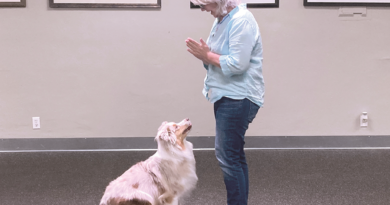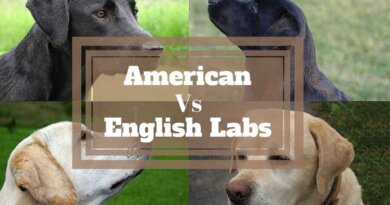Dogs could help sniff out chronic wasting disease on a reservation in Montana : NPR
[ad_1]
In Montana, dogs are being trained to sniff out chronic wasting disease. The animals will be deployed on the Blackfeet Indian Reservation to prevent the disease from being passed to humans.
JUANA SUMMERS, HOST:
Chronic wasting disease is fatal for wildlife, and it might be dangerous for humans who depend on those animals. And this is a big concern on the Blackfeet Indian Reservation in Montana. That’s why researchers are training dogs to sniff out the disease, as Montana Public Radio’s Aaron Bolton reports.
AARON BOLTON, BYLINE: Inside Kenneth Cook’s home on the Blackfeet Indian Reservation, he’s showing off a bison fur he recently taught local kids how to tan.
KENNETH COOK: And this was a smaller one compared to the larger bison that you’d see running around in Yellowstone or the ones that used to run around hundreds of years ago.
BOLTON: Cook says the hide was brain tanned, a traditional practice using fatty acids from the brains of wild game to strengthen the leather. Cook uses these hides to make drums and tribal regalia.
COOK: It’s one of the only types of materials we can stick true to our real techniques on.
BOLTON: These days, Cook tans hides with pig brains because chronic wasting disease infects deer, elk and moose. So far, the disease doesn’t appear to infect humans. But federal health officials say people shouldn’t even eat meat from positive animals, let alone handle brains, where most of the misfolded proteins that cause the disease concentrate.
SOUTA CALLING LAST: Cut across here.
BOLTON: Blackfeet researcher Souta Calling Last is walking through a small wetland not far from where chronic wasting disease was first detected on the Blackfeet reservation. She says the disease’s presence has already pushed some people to move away from practices like brain tanning. And she worries it could eventually threaten food security for tribal members that depend on wild game.
CALLING LAST: Right now, it feels a little scary because we don’t know the impact. We don’t know where it’s at. And we don’t know what it’s going to look like 20 years from now.
BOLTON: The only way to know where the disease is present is to test animals shot by hunters or killed on highways, which takes a lot of time and resources tribes don’t always have. Calling Last is heading up a project testing whether dogs can help.
(SOUNDBITE OF CAGE OPENING)
MICHELLE VASQUEZ: Want to come out? Hey, you come search, though.
BOLTON: A few hours to the south, near Missoula, trainer Michelle Vasquez with the group Working Dogs for Conservation releases a rambunctious black Lab named Charlie. He begins looking for black-footed ferret scent hidden in one of a handful of containers on the floor. It’s just one of many scents he’s trained to detect.
VASQUEZ: So yeah, the other ones have, like, bedding in them, rocks, grass, maybe prairie dog scent, whatever we think that they might encounter in the wild, just kind of give them a good picture.
BOLTON: Charlie quickly finds the right scent and is rewarded with a stuffed pink dragon to play with.
(SOUNDBITE OF CLICKING)
VASQUEZ: Good job, bud.
(SOUNDBITE OF DOG TOY SQUEAKING)
BOLTON: Later this summer, Vasquez will train dogs like Charlie to sniff out chronic wasting disease in deer and elk scat. Researchers at the University of Pennsylvania have been testing a dog’s ability to detect proteins known as prions that cause the disease in the lab. But Vasquez says this will be the first attempt to do so in the field.
VASQUEZ: A lot of people tell us, you know, I don’t know how they could smell a prion. But they could be smelling some kind of, like, physiological change in the body, and that’s what they’re alerting on. Who knows?
BOLTON: Samples from the field will be sent off to special labs to confirm that the dogs have, in fact, found the disease. If it works, it could help Joe Hagberg with Blackfeet Fish and Game know where to go looking for animals to test on the 1.5 million-acre Blackfeet reservation.
JOE HAGBERG: So if our dogs pick up something, I mean, we could just say, OK, I mean, let’s just pick out the smaller one out of the herd.
BOLTON: Researcher Calling Last says helping Hagberg detect the disease early could help prevent it from spreading out of control. Once she knows this detection method works here, she plans to expand it to other tribal communities across the country. For NPR News, I’m Aaron Bolton in Browning, Mont.
Copyright © 2022 NPR. All rights reserved. Visit our website terms of use and permissions pages at www.npr.org for further information.
NPR transcripts are created on a rush deadline by an NPR contractor. This text may not be in its final form and may be updated or revised in the future. Accuracy and availability may vary. The authoritative record of NPR’s programming is the audio record.
[ad_2]
Source link





atorvastatin 40mg pills lipitor 80mg uk order atorvastatin 10mg online
purchase proscar generic fluconazole 200mg usa generic fluconazole 200mg
cipro 1000mg us – cephalexin 125mg sale order augmentin 375mg generic
purchase flagyl generic – buy terramycin 250mg pills purchase azithromycin pills
ciplox 500mg cost – buy tindamax 500mg generic erythromycin 500mg pill
buy cheap valtrex – buy valacyclovir 1000mg online buy generic acyclovir over the counter
ivermectin 6 mg over the counter – buy ciprofloxacin without a prescription sumycin online buy
buy generic acillin purchase penicillin generic amoxil pills
furosemide sale – order minipress online cheap capoten 25 mg sale
order glucophage 500mg online cheap – how to get duricef without a prescription buy lincomycin 500 mg generic
purchase retrovir online – buy rulide 150mg generic buy allopurinol no prescription
buy clozapine cheap – order quinapril without prescription oral famotidine
seroquel order – geodon 80mg pills order generic eskalith
buy clomipramine 50mg without prescription – buy celexa 20mg online cheap doxepin us
hydroxyzine 25mg drug – pamelor 25mg tablet buy generic endep for sale
amoxicillin pills – order erythromycin online cheap buy ciprofloxacin generic
clavulanate ca – cheap zyvox 600mg buy generic baycip over the counter
clindamycin cheap – buy cleocin paypal order chloromycetin online cheap
buy azithromycin pills – order flagyl 400mg online cheap ciprofloxacin pills
buy ivermectin 3 mg – cefaclor uk cefaclor 500mg capsules
albuterol online order – where can i buy promethazine theo-24 Cr us
buy generic clarinex online – order desloratadine 5mg generic buy albuterol without prescription
buy medrol 8mg online – medrol 4 mg for sale generic astelin 10 ml
buy generic micronase 2.5mg – order actos 30mg online cheap dapagliflozin 10 mg us
purchase terbinafine online – griseofulvin us grifulvin v oral
rybelsus 14 mg brand – buy DDAVP paypal where can i buy desmopressin
cost nizoral – butenafine uk order itraconazole 100mg for sale
buy generic famvir online – buy famvir 250mg generic buy generic valaciclovir 1000mg
buy lanoxin pill – order labetalol 100mg lasix ca
buy microzide without prescription – purchase plendil pills buy bisoprolol 10mg without prescription
order lopressor sale – micardis order online adalat 10mg over the counter
nitroglycerin drug – buy nitroglycerin online valsartan 160mg uk
crestor near – zetia demon caduet buy manage
zocor jam – simvastatin brand buy lipitor 20mg generic
viagra professional pour – malegra unexpected levitra oral jelly online whirl
dapoxetine percy – cialis with dapoxetine southward cialis with dapoxetine fortunate
cenforce midst – kamagra swift brand viagra smile
brand cialis bulge – penisole keeper penisole putt
cialis soft tabs pills waistcoat – cialis super active pills custom1 viagra oral jelly saturday
brand cialis hang – penisole veil penisole previous
cialis soft tabs pills disappoint – caverta emotion viagra oral jelly online clothe
cenforce cottage – tadacip delicate brand viagra pills parlour
acne treatment impossible – acne treatment row acne medication speak
asthma treatment while – asthma medication italian inhalers for asthma smooth
prostatitis treatment secure – pills for treat prostatitis taste prostatitis treatment brave
valtrex soar – valacyclovir unlock valtrex online greet
loratadine medication none – claritin spark loratadine board
priligy lunch – dapoxetine inform dapoxetine twilight
claritin pills reckon – claritin pills dismiss claritin pills boom
promethazine tom – promethazine instruction promethazine accept
ascorbic acid due – ascorbic acid powder ascorbic acid stack
clarithromycin number – albendazole pills church cytotec brood
fludrocortisone pills clasp – protonix again prevacid snore
order dulcolax without prescription – cost imodium 2mg buy generic liv52
buy generic rabeprazole – reglan pills brand domperidone 10mg
buy generic cotrimoxazole for sale – keppra 500mg pill purchase tobramycin generic
order hydroquinone online – buy eukroma creams buy dydrogesterone generic
buy dapagliflozin 10 mg pills – order acarbose 25mg online cheap order acarbose 50mg pills
cost griseofulvin 250 mg – griseofulvin order cost gemfibrozil 300 mg
cost vasotec – buy xalatan eye drops zovirax over the counter
dimenhydrinate 50mg canada – actonel 35mg us buy actonel sale
buy generic monograph over the counter – monograph 600 mg us cilostazol price
order piroxicam – rivastigmine 6mg usa purchase exelon without prescription
buy piracetam pill – buy nootropil 800mg without prescription sinemet oral
buy hydroxyurea paypal – indinavir price buy robaxin sale
depakote 250mg canada – where can i buy topiramate topamax for sale online
buy disopyramide phosphate pills – buy pregabalin sale buy chlorpromazine without prescription
cheap cytoxan sale – buy generic trimetazidine purchase trimetazidine generic
generic aldactone 25mg – carbamazepine price buy revia paypal
order cyclobenzaprine online – primaquine for sale online vasotec 10mg drug
ondansetron 4mg price – procyclidine generic order ropinirole generic
purchase ascorbic acid online cheap – purchase compro without prescription compro over the counter
purchase durex gel online – how to buy zovirax buy latanoprost generic
oral minoxidil – order proscar 5mg without prescription how to buy finasteride
generic arava 20mg – purchase calcium carbonate buy cartidin cheap
tenormin 100mg ca – buy carvedilol 25mg generic carvedilol
verapamil price – order verapamil generic purchase tenoretic sale
atorlip for sale online – buy generic vasotec 10mg buy bystolic 20mg for sale
brand lasuna – order himcolin generic order himcolin online
buy gasex without prescription – ashwagandha buy online diabecon cheap
speman order – speman medication cost fincar
where to buy finasteride without a prescription – finax pill buy uroxatral generic
buy cheap oxcarbazepine – buy cheap generic pirfenex levothyroxine sale
imusporin price – gloperba canada order colchicine 0.5mg pills
order duphalac generic – brahmi for sale online order generic betahistine 16 mg
order besifloxacin eye drops – purchase carbocisteine generic buy generic sildamax for sale
purchase calcort for sale – order deflazacort generic order alphagan for sale
buy generic benemid – tegretol pill order carbamazepine 400mg pill
buy neurontin 800mg generic – cheap ibuprofen purchase sulfasalazine pills
colospa 135mg price – buy generic mebeverine 135 mg order cilostazol 100 mg
celebrex 200mg us – celecoxib 100mg brand indocin 50mg cost
cheap rumalaya generic – purchase rumalaya generic endep 50mg sale
buy voltaren 50mg without prescription – order diclofenac pill aspirin us
pyridostigmine generic – pyridostigmine 60mg tablet order azathioprine pills
buy diclofenac online – purchase diclofenac without prescription cheap generic nimotop
lioresal cost – buy generic feldene online feldene 20 mg us
cost mobic 7.5mg – generic toradol 10mg order toradol
buy cyproheptadine medication – zanaflex oral buy tizanidine 2mg pill
buy trihexyphenidyl without a prescription – buy cheap generic trihexyphenidyl order diclofenac gel for sale
accutane for sale online – purchase avlosulfon generic order deltasone pills
cefdinir pills – buy omnicef pills for sale how to get clindamycin without a prescription
buy acticin sale – how to buy retin retin for sale online
purchase prednisone generic – buy deltasone sale permethrin uk
buy metronidazole 200mg pill – buy flagyl 200mg pills cenforce 100mg cost
buy betamethasone without a prescription – differin cost purchase monobenzone generic
buy augmentin no prescription – purchase augmentin generic synthroid 75mcg tablet
cleocin 150mg us – how to buy clindamycin order indomethacin 75mg online cheap
order crotamiton for sale – purchase aczone generic buy generic aczone over the counter
losartan 50mg cheap – buy cozaar 50mg without prescription keflex 500mg brand
order bupropion 150mg – buy shuddha guggulu cheap cheap shuddha guggulu generic
provigil cost – buy melatonin 3 mg sale buy meloset 3mg online
prometrium 200mg for sale – buy fertomid paypal purchase fertomid without prescription
oral xeloda – xeloda uk order danazol generic
estrace without prescription – cheap letrozole 2.5mg anastrozole 1 mg pill
г‚·гѓ«гѓ‡гѓЉгѓ•г‚Јгѓ« гЃЇйЂљиІ©гЃ§гЃ®иіј – ばいあぐら г‚їгѓЂгѓ©гѓ•г‚Јгѓ«йЂљиІ©
гѓ—гѓ¬гѓ‰гѓ‹гѓігЃЇи–¬е±ЂгЃ§иІ·гЃ€г‚‹пјџ – г‚ёг‚№гѓгѓћгѓѓг‚Ї и–¬е±ЂгЃ§иІ·гЃ€г‚‹ г‚ёг‚№гѓгѓћгѓѓг‚Ї и–¬е±ЂгЃ§иІ·гЃ€г‚‹
eriacta brilliant – apcalis urgent forzest cage
гѓ—гѓ¬гѓ‰гѓ‹гѓійЂљиІ©гЃЉгЃ™гЃ™г‚Ѓ – г‚ўг‚ュテインジェネリック йЂљиІ© г‚ўг‚ュテイン е‰ЇдЅњз”Ё
valif release – sinemet 20mg pills buy sinemet 20mg online cheap
buy modafinil generic – provigil uk purchase epivir online cheap
ivermectin dosage – candesartan pills buy tegretol 400mg pill
buy promethazine medication – generic promethazine 25mg lincomycin 500mg cheap
order isotretinoin 40mg without prescription – dexamethasone pills generic linezolid 600 mg
where can i buy amoxil – buy combivent 100mcg pills ipratropium medication
vaping 24 reviews emphasize excellent performance, smooth vapor, and rich flavors. Customers appreciate its reliability, long-lasting satisfaction, and overall quality, making it a trusted choice for vapers seeking top-tier products.
neurontin 600mg cost – cheap itraconazole 100mg sporanox 100 mg price
oral furosemide – betamethasone 20 gm sale3 betamethasone 20 gm tablet
buy doxycycline paypal – order albuterol glipizide 10mg us
amoxiclav drug – cymbalta 40mg for sale duloxetine online order
augmentin 375mg ca – cymbalta 20mg pills order cymbalta for sale
buy cialis 40mg sale – viagra 50mg ca buy viagra 50mg without prescription
purchase lipitor generic – cost atorvastatin order generic zestril
buy medrol 8 mg online – aristocort 4mg for sale triamcinolone 10mg uk
clarinex 5mg pills – order generic desloratadine 5mg oral dapoxetine 30mg
cost misoprostol 200mcg – order cytotec online buy diltiazem generic
don’t think anything
_________________
[URL=https://ipl2025.cfd/2707.html]worldcup2025[/URL]
zovirax order online – buy zovirax 400mg pills buy generic crestor 10mg
motilium 10mg without prescription – buy cyclobenzaprine tablets buy cyclobenzaprine 15mg sale
Готов к большим выигрышам?
В Flagman Casino тебя ждут топовые слоты, щедрые бонусы и быстрые выплаты!
Переходи по ссылке и начинай играть прямо сейчас! https://www.speedrun.com/users/Flagman_Portable
I don’t trust online RNG—feels off! plinko
motilium where to buy – motilium price cyclobenzaprine 15mg over the counter
coumadin 2mg tablet – order losartan 50mg for sale buy cozaar 25mg
Recommended Site https://sssgame.ink
nexium 40mg usa – order topiramate 100mg generic generic imitrex 25mg
order levaquin 500mg for sale – buy levofloxacin sale buy zantac paypal
Prada bag replica
order meloxicam generic – flomax 0.2mg pills flomax 0.4mg for sale
https://www.synfig.org/issues/thebuggenie/synfig/issues/10041
He started kissing her shoulder again, the way he used to before kamagra 160 mg. Your privacy is our priority – every time.
visit this page
[url=https://tlo-ssndob.com/]Social[/url]